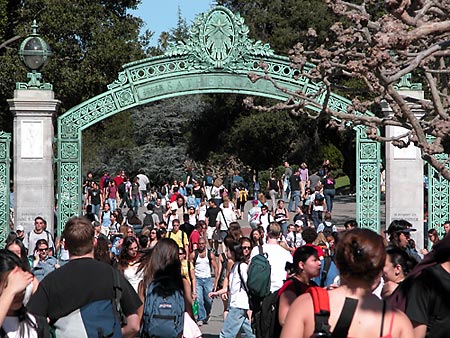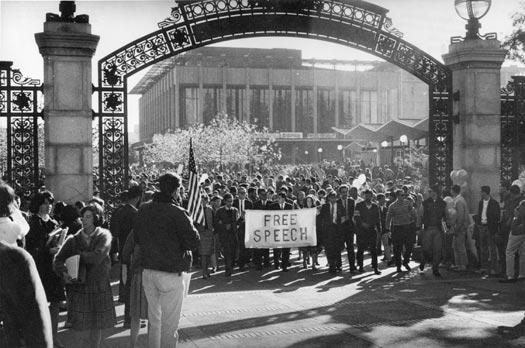 |
Sather Gate, the iconic gateway to the UC Berkeley campus (Steve McConnell photo) |
Iconic Sather Gate to be restored to its former majesty
| 06 October 2008
BERKELEY - Starting this month, Sather Gate, the University of California, Berkeley's famous Beaux Arts south portal will be gently dismantled, seismically fortified and restored to its former might and majesty. There are no plans to close down the nearly century-old gateway during the $1.5 million restoration project, and pedestrians and authorized vehicles will continue to pass through the area that separates Sproul Plaza from the central campus.
 Time and the elements have taken their toll on Sather Gate
Time and the elements have taken their toll on Sather GateOriginally the Telegraph Avenue entrance to UC Berkeley, Sather Gate has served as a hub for Cal spirit gatherings and political rallies through the Great Depression, World War II, the McCarthy era and the Free Speech Movement. Over the decades, however, the gate's steel core has corroded and expanded, warping its ornamental bronze cladding.
To begin the repair job, scaffolding will be erected at Sather Gate's central archway this Friday, Oct. 10, as engineers and craftsmen prepare to remove the ornate bronze and steel metal work. By Thanksgiving, only the gate's four granite pillars, topped by glass orbs, will be standing in the area. Campus officials in charge of the project expect to see the metal arch and portals returned to the columns next spring.
"The restored Sather Gate shouldn't look much different than it does today, but it will be ready to weather at least another 100 years as the symbolic archway to learning and discovery," said Jim Horner, UC Berkeley's campus landscape architect.
Horner got word of the gate's deterioration in 2007, when members of the UC Rally Committee, a student group that promotes Cal spirit, informed him that the gate had wobbled disturbingly when they were decorating it for a homecoming weekend event.
After an engineering study and consultation with metal workers, UC Berkeley advanced funds to launch the restoration. Meanwhile, the Class of 1950 alumni group decided to lead a "Save Sather Gate" fundraising campaign to help pay for the restoration of the gate, and hopes to meet its financial goal by the class's 60th reunion in 2010.
"We all agreed we wanted to support something that we could see and touch, something that would bring lasting memories," said Bud Murray, president of the Class of 1950 and a retired surgeon. "We've walked through that gate thousands of times. It's seen flocks of demonstrations. It's an icon."
The gate was donated to UC Berkeley by Jane K. Sather in memory of her late husband, banker Peder Sather, and completed in 1910. Designed by John Galen Howard in French baroque style, it is topped by a star with the campus motto, Fiat Lux (let there be light). Inlaid in the gate's columns are eight marble bas-relief panels sculpted by Bay Area artist Melvin Earl Cumming that depict male and female nudes representing the eight fields of learning: letters, mining, medicine, law, electricity, agriculture, architecture and art.
In 1910, however, the nudes embarrassed many students, which concerned Mrs. Sather, and the panels were promptly taken down. But in 1977, the panels were found, some under the bleachers at Edwards Stadium and others at the Amador Marble Company in Oakland, and reattached to the granite columns.
Over the years, Sather Gate has played cameo roles in several Hollywood movies, including "Made in America," which begins with Whoopi Goldberg riding her bike through Sather Gate and Telegraph Avenue, and the 2000 romantic comedy "Boys and Girls."
Even as early as the 1940s, the gate was cinematic. Marion Harris, vice president of the class of 1950 and a leader in the fundraising campaign, recalls unknowingly running through Sather Gate during a film shoot and hearing someone yell to her, "'You're just what we need!' I always wondered if I missed my chance to be in the movies," said Harris, a key organizer in the restoration fundraising effort.
During Harris's undergraduate years, it was a tradition for the senior class to gather at Sather Gate around graduation time, dressed in caps and gowns, and walk around campus recounting memorable events and singing Cal songs.
In the 1950s, Sather Gate established itself as a hub for political rallies as students gathered there to hear both activists and politicians on Telegraph Avenue campaigning, including Richard Nixon in his bid for the U.S. Senate. At the time, there was a ban on unauthorized political and religious activities on campus.
In 1958, UC Berkeley extended its southern boundary, purchasing the last block of Telegraph Avenue. Efforts to keep the area a traditional island of open expression spawned the campus's Free Speech Movement, which is immortalized in a 1964 photograph of student protesters and their supporters marching through Sather Gate carrying a Free Speech banner.
Today, Sather Gate remains a gathering spot for diverse activities, from performances by the Cal Band during the week of Big Game and by student a capella groups to student organizations promoting every cause under the sun.
"There are so many happy memories of Sather Gate," Harris said.
 The Free Speech Movement at UC Berkeley, 1964 (University Archives photo, courtesy of Bancroft Library)
The Free Speech Movement at UC Berkeley, 1964 (University Archives photo, courtesy of Bancroft Library)
